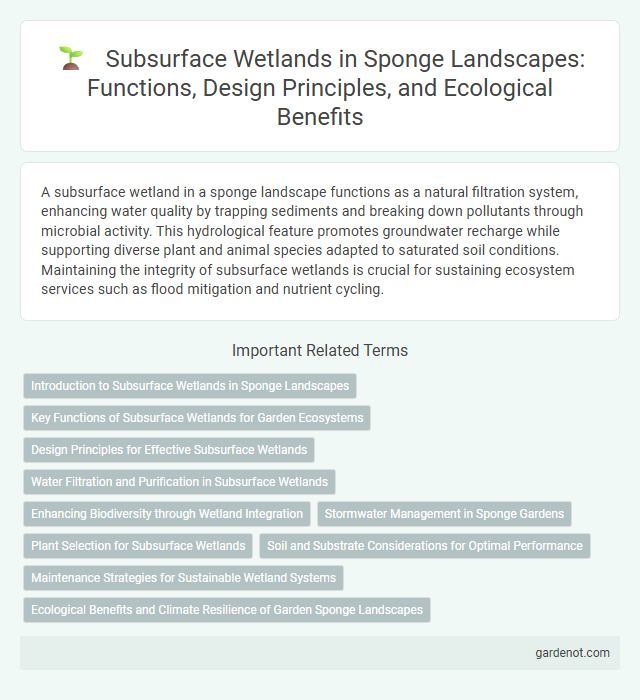A subsurface wetland in a sponge landscape functions as a natural filtration system, enhancing water quality by trapping sediments and breaking down pollutants through microbial activity. This hydrological feature promotes groundwater recharge while supporting diverse plant and animal species adapted to saturated soil conditions. Maintaining the integrity of subsurface wetlands is crucial for sustaining ecosystem services such as flood mitigation and nutrient cycling.
Introduction to Subsurface Wetlands in Sponge Landscapes
Subsurface wetlands in sponge landscapes function as natural water filtration systems by channeling runoff through permeable soils and root zones, enhancing groundwater recharge and nutrient cycling. These wetlands improve water quality by trapping sediments, absorbing contaminants, and supporting diverse microbial communities that break down pollutants. Their integration within sponge landscapes promotes ecosystem resilience and mitigates flooding through controlled water retention.
Key Functions of Subsurface Wetlands for Garden Ecosystems
Subsurface wetlands enhance garden ecosystems by efficiently filtering pollutants and excess nutrients through their root systems, improving water quality and preventing soil contamination. They provide critical habitat for beneficial microorganisms that support plant health and promote biodiversity. These wetlands also regulate groundwater levels, maintaining soil moisture balance and reducing the risk of plant stress during dry periods.
Design Principles for Effective Subsurface Wetlands
Effective subsurface wetland design prioritizes maximizing contact between wastewater and the filter media, often gravel or sand, to enhance pollutant removal through physical, chemical, and biological processes. Maintaining adequate hydraulic retention time and ensuring uniform flow distribution are critical to prevent short-circuiting and optimize treatment efficiency. Selecting appropriate vegetation such as Phragmites australis contributes to root oxygenation, supporting microbial communities essential for nutrient cycling and contaminant degradation.
Water Filtration and Purification in Subsurface Wetlands
Subsurface wetlands enhance water filtration and purification by leveraging a complex matrix of soil, plants, and microbial communities that trap and break down pollutants, including nitrogen, phosphorus, and pathogens. The porous substrate facilitates anaerobic and aerobic processes essential for degrading organic contaminants and transforming harmful nutrients into less toxic forms. This natural biofiltration system improves water quality, reduces eutrophication risks, and supports sustainable groundwater recharge.
Enhancing Biodiversity through Wetland Integration
Subsurface wetlands enhance biodiversity by creating diverse microhabitats that support a wide range of aquatic and terrestrial species. Integrating these wetlands into sponge landscape designs improves water filtration and nutrient cycling, fostering richer ecosystems. This habitat connectivity promotes species diversity, resilience, and ecological stability in urban and natural environments.
Stormwater Management in Sponge Gardens
Subsurface wetlands in sponge gardens enhance stormwater management by naturally filtering and retaining runoff through porous soil layers and dense root systems. These engineered wetland beds promote groundwater recharge while mitigating flooding and pollutant loads. Integrating subsurface treatment in sponge landscapes optimizes urban resilience against stormwater-related challenges.
Plant Selection for Subsurface Wetlands
Selecting appropriate plants for subsurface wetlands is crucial for efficient water filtration and habitat support. Native species such as Carex, Schoenoplectus, and Juncus thrive in saturated soils and promote microbial activity essential for nutrient removal. Deep-rooted plants stabilize the substrate, enhance oxygen transfer to microbial communities, and improve overall system performance in sponge landscape designs.
Soil and Substrate Considerations for Optimal Performance
Soil texture and permeability are critical in subsurface wetland design to ensure effective water retention and filtration, with loamy or silty soils providing ideal balance for microbial activity and nutrient uptake. Substrate composition, often a mix of sand, gravel, and organic matter, supports root anchorage and enhances pollutant degradation through increased surface area and oxygen diffusion. Proper layering and maintenance of the substrate prevent clogging, sustaining hydraulic conductivity and maximizing the wetland's sponge-like performance for urban stormwater management.
Maintenance Strategies for Sustainable Wetland Systems
Maintaining subsurface wetlands involves regular monitoring of water quality parameters such as nutrient levels, pH, and dissolved oxygen to ensure optimal conditions for microbial and plant health. Periodic removal of accumulated sediments and invasive plant species prevents system clogging and maintains hydraulic efficiency, crucial for sustained water purification. Implementing adaptive management practices based on site-specific data enhances the resilience and long-term functionality of subsurface wetland systems within sponge landscapes.
Ecological Benefits and Climate Resilience of Garden Sponge Landscapes
Subsurface wetlands in garden sponge landscapes enhance ecological benefits by improving water filtration, promoting biodiversity, and supporting nutrient cycling through root-zone microbial activity. These engineered systems increase climate resilience by regulating groundwater levels, mitigating flood risks, and sequestering carbon in wetland soils. Integrating subsurface wetlands with sponge landscape designs maximizes urban green infrastructure performance, contributing to sustainable water management and ecosystem health.
Subsurface wetland Infographic

 gardenot.com
gardenot.com